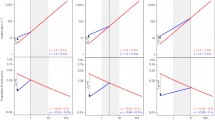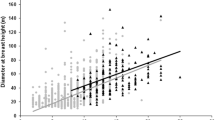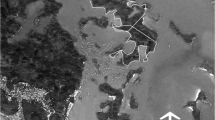Abstract
Members of a single group of green monkeys spent, on average, 44.8% of their waking time foraging, 46.7% resting, and 8.5% in social activities, over 1 year. There was significant variation in activity budgets over months (ranging from 35 to 55% of the time spent feeding). Diurnal rhythms of feeding and ranging were influenced by the daily cycle of temperature in predictable ways in different seasons: in the dry season, activity was reduced if it was too hot or too cold, while the temperature in the wet season did not affect activities. Feeding was also synchronized among individuals on a finer time scale, irrespective of the time of day. There was closer synchrony when feeding on less common foods. An ecological model of foraging time and energetics was tested, using estimates of the costs and benefits of foraging and predicting how these are optimally balanced in relation to the food density. Both feeding time and distance traveled increased as food availability increased. Costs and benefits were balanced over several days. Comparisons between populations of Cercopithecus aethiopswere made; differences in time budgets were compared with differences in the availability and quality of food. Insufficient comparative data are available for firm conclusions about the role of different energetic and nutritive strategies in population differences.
Similar content being viewed by others
References
Altmann, J. (1974). Observational study of behaviour: Sampling methods.Behaviour 49: 227–265.
Altmann, S. A., and Altmann, J. (1970).Baboon Ecology: African Field Research, University of Chicago Press, Chicago.
Baldwin, P. J. (1979).The Natural History of the Chimpanzee (Pan troglodytes verus)at Ml. Assarik, Senegal, Ph.D. thesis, University of Stirling, Stirling.
Chalmers, N. R. (1968). Group composition, ecology and daily activities of free-living mangabeys in Uganda.Folia primatol. 8: 247–262.
Charles-Dominique, P. (1971). Eco-éthologie des Prosimiens du Gabon.Biol. Gabon. 7: 121–228.
Chivers, D. J. (1977). The feeding behaviour of siamang (Symphalangus syndactylus). In Clutton-Brock, T.H. (ed.),Primate Ecology: Studies of Feeding and Ranging Behavior in Lemurs, Monkeys, and Apes, Academic Press, London, pp. 355–382.
Clutton-Brock, T. H. (1974). Activity patterns of red colobus (Colobus badius tephrosceles). Folia primatol. 21: 161–187.
Clutton-Brock, T. H. (1975). Ranging behaviour of red colobus (Colobus badius tephrosceles) in the Gombe National Park.Anim. Behav. 23: 706–722.
Clutton-Brock, T. H. (ed.) (1977).Primate Ecology: Studies of Feeding and Ranging Behaviour in Lemurs, Monkeys, and Apes, Academic Press: London.
Clutton-Brock, T. H., and Harvey, P. H. (1977). Species differences in feeding and ranging behaviour in primates. In Clutton-Brock, T.H. (ed.),Primate Ecology: Studies of Feeding and Ranging Behaviour in Lemurs, Monkeys, and Apes, Academic Press, London, pp. 557–579.
Dandelot, P. (1959). Note sur la classification des Cercopitheques du groupeaethiops. Mammalia 23: 357–368.
Doyle, G. A. (1974). Behavior of prosimians. In Schrier, A.M., and Stollnitz, F. (ed.),Behaviour of Nonhuman Primates, Vol. 5, Academic Press, New York and London, pp. 155–353.
Dunbar, R. I. M. (1977). Feeding ecology of gelada baboons: A preliminary report. In Clutton-Brock, T.H. (ed.),Primate Ecology: Studies of Feeding and Ranging Behaviour in Lemurs, Monkeys, and Apes, Academic Press, London, pp. 251–273.
Dunbar, R. I. M., and Dunbar, E. P. (1974). Ecological relations and niche separation between sympatric terrestrial primates in Ethiopia.Folia primatol. 21: 36–60.
Galat, G., and Galat-Luong, A. (1976). La colonisation de la mangrove parCercopithecus aethiops sabaeus au Senegal.Terre Vie 30: 3–30.
Galat, G., and Galat-Luong, A. (1977). Démographie et régime alimentaire d’une troupe deCercopithecus aethips, Lolui Island, Lake Victoria.Proc. Zool. Soc. Lond. 145: 37–56. 557–577.
Hall, K. R. L., and Gartlan, J. S. (1965). Ecology and behaviour of the vervet monkey,Cercopithecus aethiops, Lolui Island, Lake Victoria.Proc. Zool. Soc. Lond. 145: 37–56.
Hamilton, W. D. (1971). Geometry for the selfish herd.J. Theor. Biol. 31: 295–311.
Harrison, M. J. S. (1982).The Behavioural Ecology of Green Monkeys, Cercopithecus sabaeus,at Mt. Assirik, Senegal, Ph.D. Thesis, University of Stirling, Stirling.
Harrison, M. J. S. (1983a). Territorial behaviour in the green monkey,Cercopithecus sabaeus: Seasonal defense of local food supplies.Behav. Ecol. Sociobiol. 12: 85–94.
Harrison, M. J. S. (1983b). Age and sex differences in the diet and feeding strategies of the green monkey,Cercopithecus sabaeus. Anim. Behav. 31: 969–977.
Harrison, M. J. S. (1983c). Patterns of range use by the green monkey,Cercopithecus sabaeus, at Mt. Assirik, Senegal,Folia primatol. 41: 157–179.
Harrison, M. J. S. (1984). Optimal foraging strategies in the diet of the green monkey,Cercopithecus sabaeus, at Mt. Assirik, Senegal.Int. J. Primatol. 5: 435–471.
Hladik, C. M. (1977). Chimpanzees of Gabon and chimpanzees of Gombe: Some comparative data on the diet. In Clutton-Brock, T.H. (ed.),Primate Ecology: Studies of Feeding and Ranging Behaviour in Lemurs, Monkeys, and Apes, Academic Press, London, pp. 481–503.
Homewood, K. M. (1978). Feeding strategy of the Tana mangabeyCercocebus galerilus galeritus. J. Zool. (London) 186: 375–391; 53(3): 573–597.
Katz, P. L. (1974). A long-term approach to foraging optimization.Am. Nat. 108: 758–782.
Kavanagh, M. (1977).Some Inter-population Variation in the Behavioural Ecology of Cercopithecus aethiops sabaeus, Ph.D. thesis, University of Sussex, Sussex.
Kavanagh, M. (1978). The diet and feeding behaviour ofCercopithecus aethiops tantalus. Folia primatol. 30: 30–63.
Kleiber, M. (1961).The Fire of Life: An Introduction to Animal Energetics, Wiley, New York.
Krebs, J. R. (1978). Optimal foraging: Decision rules for predators. In Krebs, J.R., and Davies, N.B. (ed.),Behavioural Ecology, Blackwell, Oxford, pp. 23–63.
Krebs, J. R., and Davies, N. B. (1978).Behavioural Ecology, Blackwell, Oxford.
Kummer, H. (1968).Social Organization of Hamadryas Baboons, University of Chicago Press, Chicago.
Kummer, H. (1971).Primate Societies: Group Techniques of Ecological Adaptation, Aldine-Atherton, Chicago.
Lindburg, D. G. (1977). Feeding behaviour and diet of rhesus monkeys (Macaca mulatta) in a Siwalik forest in north India. In Clutton-Brock, T.H. (ed.),Primate Ecology: Studies of Feeding and Ranging Behaviour in Lemurs, Monkeys, and Apes, Academic Press, London, pp. 223–249.
Marsh, C. (1978). Comparative activity budgets of red colobus. In Chivers, D.J., and Herbert, J. (ed.),Recent Advances in Primatology, Vol. I. Behaviour, Academic Press, London, pp. 249–251.
Marsh, C. (1981). Time budget of Tana River red colobus.Folia primatol. 35: 30–50.
McGrew, W. C., Baldwin, P. J., and Tutin, C. E. G. (1981). Chimpanzees in a hot, dry, and open habitat: Mt. Assirik, Senegal, West Africa.J. Hum. Evol. 10: 227–244.
Nie, N. H., Hull, C. H., Jenkin, J. G., Steinbrenner, K., and Brent, D. H. (1975).Statistical Package for the Social Sciences, McGraw-Hill, New York.
Norberg, R. A. (1977). An ecological theory on foraging time and energetics.J. Anim. Ecol. 46: 511–529.
Oates, J. F. (1977). The guereza and its food. In Clutton-Brock, T.H. (ed.),Primate Ecology: Studies of Feeding and Ranging Behaviour in Lemurs, Monkeys, and Apes, Academic Press, London, pp. 276–323.
Oliver, J. I., and Lee, P. C. (1978). Comparative aspects of the behaviour of juveniles in two species of baboon in Tanzania. In Chivers, D.J., and Herbert, J. (ed.),Recent Advances in Primatology, Vol. I. Behaviour, Academic Press, London, pp. 151–153.
Pyke, G. H., Pulliam, H. R., and Charnov, E. L. (1977). Optimal foraging: A selective review of theory and tests.Rev. Biol. 52: 137–154.
Raemakers, J. J. (1980). Causes of variation between months in the distance travelled daily by gibbons.Folia primatol. 34: 46–60.
Richard, A. (1977). The feeding behaviour ofPropithecus verreauxi. In Clutton-Brock, T.H. (ed.),Primate Ecology: Studies of Feeding and Ranging Behaviour in Lemurs, Monkeys, and Apes, Academic Press, London, pp. 72–96.
Robinson, T. (1974). Metabolism and function of alkaloids in plants.Science 184: 430–435.
Sharman, M. J. (1981).Feeding, Ranging and Social Organization of the Guinea Baboon, Papio papio, Ph.D. thesis, University of St. Andrews, St. Andrews.
Sokal, R. R., and Rohlf, F. J. (1969).Biometry. The Principles and Practice of Statistics in Biological Research, Freeman, San Francisco.
Struhsaker, T. T. (1975).The Red Colobus Monkey, University of Chicago Press, Chicago.
Struhsaker, T. T., and Oates, J. F. (1975). Comparison of the behavior and ecology of red colobus and black-and-white colobus monkeys in Uganda: A summary. In Tuttle, R.H. (ed.).Socio-ecology and Psychology of Primates, Mouton, The Hague, pp. 101–123.
Waser, P. (1977). Feeding, ranging and group size in the mangabeyCercocebus albigena. In Clutton-Brock, T.H. (ed.),Primate Ecology: Studies of Feeding and Ranging Behaviour in Lemurs, Monkeys, and Apes, Academic Press, London, pp. 183–222.
Wrangham, R. W. (1977). Feeding behaviour of chimpanzees in Gombe National Park, Tanzania. In Clutton-Brock, T.H. (ed.),Primate Ecology: Studies of Feeding and Ranging Behaviour in Lemurs, Monkeys, and Apes, Academic Press, London, pp. 503–538.
Wrangham, R. W., and Waterman, P. G. (1981). Feeding behaviour of vervet monkeys onAcacia tortilis andAcacia xanthophloea: With special reference to reproductive strategies and tannin production.J. Anim. Ecol. 50: 715–731.
Author information
Authors and Affiliations
Rights and permissions
About this article
Cite this article
Harrison, M.J.S. Time budget of the green monkey,Cercopithecus sabaeus: Some optimal strategies. Int J Primatol 6, 351–376 (1985). https://doi.org/10.1007/BF02736383
Received:
Revised:
Issue Date:
DOI: https://doi.org/10.1007/BF02736383




